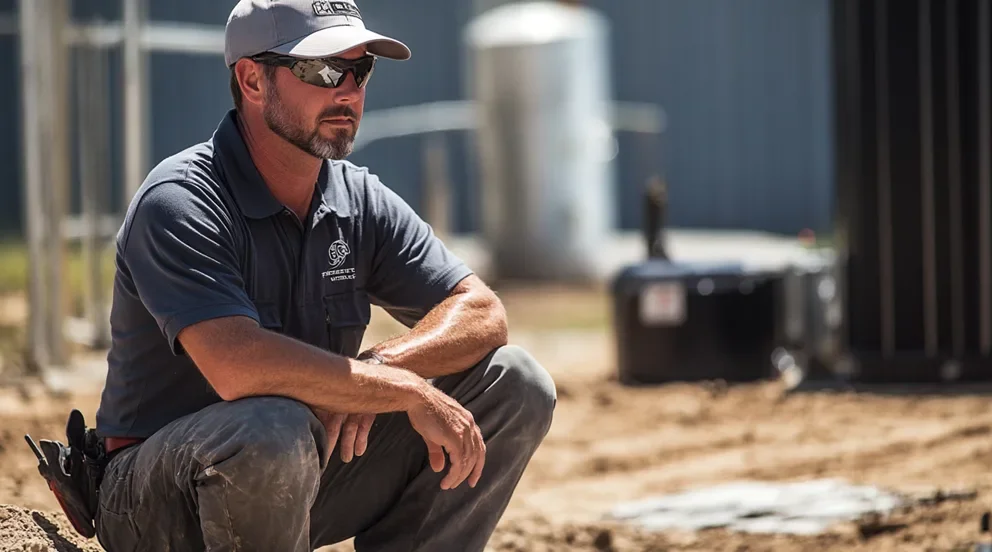When you’ve got techs in the field, every minute counts. Whether they’re caught in traffic or headed to the wrong address, that delay costs money—and patience. Field service mapping software helps contractors stay in control by showing where your crew is, where they need to be, and the best route to get there. No guesswork. Just better coordination.
It’s one piece of a larger puzzle when managing operations out in the field. From dispatch to communication to job tracking, a solid field service management system connects the dots. But this guide focuses specifically on the mapping side—what it does, why it matters, and how to pick the tool that works best for your crew.
- Choosing the right field service mapping software for your team
- 6 key features to look for in a field service mapping software
- 7 best field service mapping software for contractors
- 5 benefits of using a field service mapping software
- 4 common field service mapping software FAQs answered
Before you start comparing platforms, take a step back. Picking the right field service mapping software starts with understanding your daily challenges—then finding a tool that tackles those head-on. Let’s break down what to consider before locking anything in.
Choosing the right field service mapping software for your team
Selecting field service mapping software impacts everything from how fast your techs hit the road to how well your office can support them. It’s a decision that touches both sides of the operation—what happens behind the screen and what happens on the ground. Before diving into features and pricing, make sure the tool fits how your team actually works.
Here are five areas to think through:
- Job flow compatibility – Does this software match how you assign, track, and adjust jobs throughout the day? Ask whether it supports both pre-scheduled visits and last-minute dispatches. Can it adapt to job status changes or techs getting reassigned mid-route?
- Crew visibility needs – Look at how clearly the software shows technician locations in real time. Can dispatchers pull up maps with active routes and crew statuses? And can techs update their progress without having to stop and call in every time?
- Scalability and team size – Whether you’re running a five-person team or fifty, the platform should handle it. Think about how well it performs with multiple users logged in and whether it can scale up as you grow, without slowing down or getting messy.
- Field to office communication – Reliable updates from the field are non-negotiable. Does the platform support real-time status changes and note sharing? Can it reduce the need for constant check-ins and make it easier for dispatchers and techs to stay synced?
- Features – What tools come standard? You want mapping, GPS tracking, route optimization, and status updates. But also think about whether it ties into your existing scheduling or invoicing tools. Can it handle job notes, attach photos, or trigger alerts?
Once you’ve worked through these questions with your crew in mind, it’s time to dig into the feature set. The next section covers six must-have capabilities in any solid field service mapping software—and how each one actually helps your team get work done faster and with fewer headaches.
6 key features to look for in a field service mapping software
When the office hands off a job to the field, there’s no room for confusion. Techs need to know exactly where to go, how to get there, and what to expect when they arrive. That’s where field service mapping software earns its keep—by connecting dispatchers and field crews through real-time tracking, efficient routing, and smart coordination. Without the right tools, it’s chaos. But with software designed to handle those demands, your operation runs smoother, jobs get done faster, and no one’s left guessing.
Here are six key features that keep your crews moving and your schedules tight:
1. Intelligent dispatching and job assignment
Knowing where to send a tech is only half the battle. The real value lies in automatically sending the best person based on location, availability, and job type. Field service mapping software with smart dispatching capabilities can do just that—assigning jobs based on real-time conditions and technician status.
Take for example, a dispatcher managing four emergency calls at once—different techs, scattered across the city. With field service dispatch software tools built into their mapping platform, they can immediately see who’s closest, who’s available, and who’s qualified. No spreadsheets. No guesswork. Just faster service with fewer delays.
2. Real-time GPS tracking and route optimization
When every minute on the road cuts into your job time, efficient routing becomes critical. A strong field service mapping software shows live GPS data, optimizes travel paths, and avoids traffic delays—all while keeping the office informed.
Let’s say your tech is headed to a service call and a road closure reroutes them. Instead of losing time, the system recalculates instantly and updates both the tech and the dispatcher. Tools like those found in field service scheduling software keep jobs on track and techs one step ahead of roadblocks—literally.
3. Mobile access for field technicians
Your techs shouldn’t have to stop and call in just to get directions or job updates. With mobile-ready field service mapping software, they get everything—routes, customer notes, job updates—right on their phone or tablet.
Say a tech finishes a job early and is ready for the next. Instead of waiting for a call, the next location pops up instantly in their app. Technician mobile apps built into the platform let them stay focused on the road and the work, not chasing down paperwork or playing phone tag.
4. CRM integration with job location context
Knowing where your techs are is one thing. Knowing the full job history of that location is another. CRM integration lets your field service mapping platform connect addresses with service history, notes, and contacts—making every visit smarter.
Think of a tech heading to a repeat customer who’s had recurring HVAC issues. Instead of starting cold, a CRM system connection lets them pull up past visits, what was done, and any quirks at that site. They show up prepared and save time diagnosing problems that have already been flagged before.
5. Time tracking tied to location data
It’s not just about clocking in and out. Good field service mapping software links location data with time tracking, so you know exactly when someone arrived, how long they stayed, and how long it took to travel.
For example, during a busy week, one service manager noticed productivity drops with two techs. By reviewing time tracking tied to GPS logs, they discovered both were consistently delayed between jobs due to inefficient routes. With that insight, dispatch adjusted assignments and saved hours each week without hiring a single extra person.
6. Reporting based on location performance
You can’t fix what you can’t measure. Advanced mapping tools offer location-based reporting—showing which areas take the most time, where delays pile up, and which routes keep crews productive.
For instance, after pulling a quarterly report using reporting software, a contractor realized their east side routes were consistently delayed due to outdated routing logic. With this data, they rerouted service zones and improved response times across the board. No more guesswork—just performance you can track by zip code.
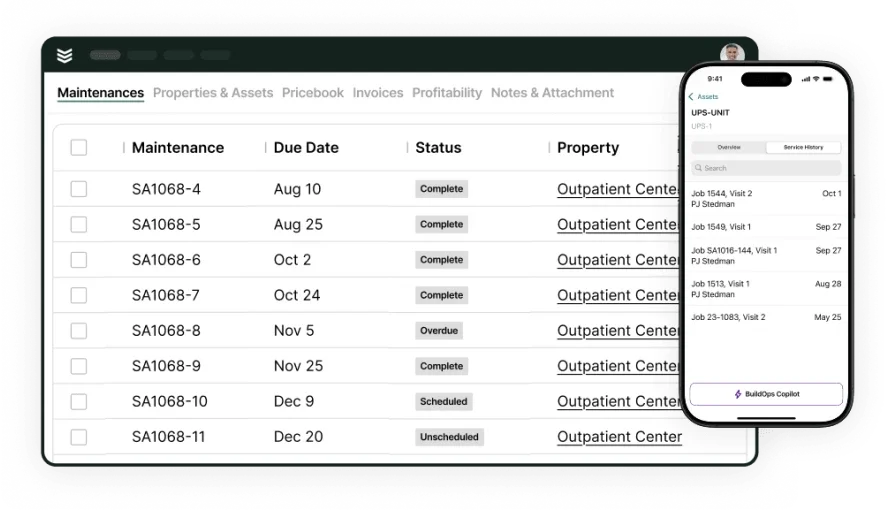
Explore our service management suite
Equip your field technicians with everything they need to tackle projects.
Other notable field service mapping features to look for
Beyond the core features, some tools come with extra capabilities that can make daily fieldwork easier—especially for contractors managing larger crews or high-volume routes. These aren’t always deal-breakers, but they do add value when you’re scaling up, tightening processes, or simply looking to reduce back-and-forth between your field and office teams.
- Service agreement management – For teams handling recurring visits or preventive maintenance, built-in service agreement features make it easier to tie mapped routes to contract terms. These tools help track upcoming jobs, schedule visits automatically, and log all work done under a specific agreement—keeping dispatch and field teams aligned without extra manual tracking.
- Quoting tools linked to job locations – With quoting software, some field service mapping systems allow techs or office staff to generate quotes directly tied to specific sites. This speeds up customer approvals and helps the team respond quickly while on-site—especially useful when techs identify add-on work that wasn’t planned for.
- Integrated invoicing and payments – Closing the loop after a job gets easier when invoicing and payment tools are connected to your mapping system. Once a job’s marked complete, the platform can auto-generate invoices and send them to customers—no duplicate data entry, no delay. Payments can even be processed directly, which shortens your cash cycle and reduces admin follow-up.
You’ve now seen what solid field service mapping software brings to the table—from live dispatch and GPS to the bonus tools that help tighten your backend process. So what platforms actually offer this kind of functionality? Let’s take a look at the best options on the market for different types of contractors.
7 best field service mapping software for contractors
Choosing field service mapping software isn’t one-size-fits-all. The best tool depends on the type of jobs you run, the size of your fleet, and the complexity of your scheduling needs. Below are seven top options—each built with different contractor needs in mind.
1. Best for commercial: BuildOps
BuildOps is designed specifically for commercial contractors, offering deep visibility into your operations—from the dispatch board to real-time technician locations. What sets it apart is how it merges mapping with scheduling, quoting, and reporting, all in one platform.
How pricing works: Pricing is custom, based on company size and operational needs; request a demo to get accurate details.
Features beyond mapping: In addition to GPS mapping and dispatch visibility, BuildOps integrates live job scheduling, invoice generation, and on-the-go quoting. Field techs can view and update job details through a mobile app that syncs instantly with the office. Everything flows through one platform, cutting out the lag between systems and departments.
What sets it apart for commercial teams: BuildOps supports high-volume field teams with powerful automation, route planning, and reporting tools that scale. It’s built with the specific pace and pressure of commercial contracting in mind.
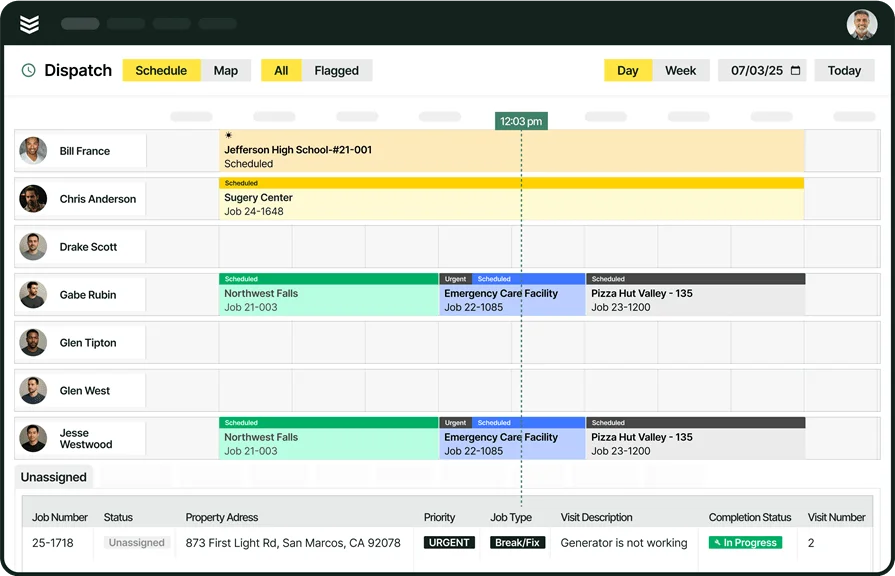
Streamline operations and boost profits
Track every crew, vehicle, and job in real time—make every decision count.
2. Best for residential: Housecall Pro
Image Source: Housecall Pro
Housecall Pro is built for home service pros looking for a clean interface and quick setup. It handles basic mapping and dispatch tasks well and offers a customer-facing app for residential clients to manage appointments and payments. However, its mapping features may feel limited for companies juggling complex or high-volume routes.
How pricing works: Starts at around $59/month per user for the basic plan, with tiered pricing based on feature access.
Features beyond mapping: Housecall Pro includes invoicing, customer communication tools, and payment processing. Its simple mobile interface is great for techs working solo or in small teams. You can also use its job history and reminders to help reduce missed appointments.
What sets it apart for residential contractors: Great for shops that don’t need complex routing logic or multi-layered team coordination. It’s easy to pick up and scale gradually.
3. Best for general contractors: FieldEdge
Image Source: FieldEdge
FieldEdge blends field service mapping with sales tools and customer management. It’s a solid option for general contractors looking for job tracking tied closely to CRM and invoicing workflows. However, the interface can feel dated, and it may not offer the best real-time updates compared to newer competitors.
How pricing works: Custom quotes only—typically based on team size and feature needs.
Features beyond mapping: Includes full work order management, time tracking, and a QuickBooks integration. It also has dashboards for estimating job performance and profitability, which can help general contractors make better scheduling decisions.
What sets it apart for general contractors: It’s flexible enough to manage both project-based and reactive service work in one place, making it a practical all-rounder for mixed crews.
4. Best for small to mid-sized businesses: Hubstaff
Image Source: Hubstaff
Hubstaff leans heavily into workforce tracking and productivity management, making it a useful pick for small to mid-sized businesses that want visibility across distributed teams. It comes with a GPS-powered map view that tracks job progress and crew location throughout the day. That said, companies focused more on customer scheduling or service documentation might find its features limited on the service operations side.
How pricing works: Starts at $7/month per user with limited features. Premium plans with mapping and time tracking tools begin around $10/month.
Features beyond mapping: Hubstaff includes time tracking, geofencing, productivity measurement, and employee scheduling. The GPS mapping ties directly into the time logs, so you can see where your team was and when they were there. It’s especially helpful for payroll verification and job accountability.
What sets it apart for small to mid-sized businesses: It balances cost, simplicity, and transparency—great for owners who want to keep a closer eye on job flow without spending on heavy enterprise tools.
5. Best for independent contractors: FieldServicely
Image Source: FieldServicely
FieldServicely is geared toward solo operators and small teams who need basic job tracking, routing, and client management without the clutter. Its interface is straightforward and easy to navigate, ideal for contractors handling service jobs on their own. However, it may lack the depth and scalability needed for larger or fast-growing crews.
How pricing works: Offers a free plan with core features; paid plans start at $15/month for additional users and expanded integrations.
Features beyond mapping: You get digital job cards, route management, invoicing, and calendar sync. Its strength lies in its simplicity—allowing techs to create jobs, navigate to sites, and bill clients, all from one screen. Perfect for techs juggling jobs on the fly without admin support.
What sets it apart for independent contractors: Minimal setup, mobile-friendly, and focused on getting paid faster—making it a strong fit for tradespeople who handle both the wrench and the paperwork.
6. Best for ease of use: Zoho FSM
Image Source: Zoho
Zoho FSM is a great pick for teams that want mapping tools baked into a wider business suite without a steep learning curve. Its clean dashboard and plug-and-play setup make it easy for teams to get started, especially those already using other Zoho apps. However, its mapping and field tracking features may feel basic compared to platforms built specifically for high-volume service dispatching.
How pricing works: Pricing starts around $15/month per user. Higher-tier plans unlock additional features like multi-agent support and automation workflows.
Features beyond mapping: Zoho FSM includes appointment scheduling, real-time field updates, and route planning. Its mobile app is lightweight and gives field teams access to work orders, directions, and notes. It also syncs seamlessly with Zoho’s CRM and invoicing tools for tighter operations.
What sets it apart for ease of use: It’s a solid entry-level option for companies who want to digitize dispatch and mapping with minimal setup. If your team needs something fast and intuitive, Zoho hits that mark.
7. Best for multi-trade contractors: Praxedo
Image Source: Praxedo
Praxedo stands out with its flexibility across different trades—HVAC, plumbing, electrical, and more. It gives dispatchers a robust interface to assign jobs by specialty, while field crews use mobile apps for routing, reporting, and on-site job updates. However, the learning curve and price tag may be too much for small or single-trade businesses.
How pricing works: Custom pricing based on number of users and industry; typically suited for mid-size to large contractors.
Features beyond mapping: Praxedo supports multi-route planning, job documentation with photos, digital forms, and KPI dashboards. It helps dispatchers manage specialized teams across different services—especially useful for contractors running multiple trades under one roof.
What sets it apart for multi-trade contractors: Built to juggle the complexity of coordinating teams across job types. If your business spans several trades, Praxedo’s customization options help keep everything mapped and organized.
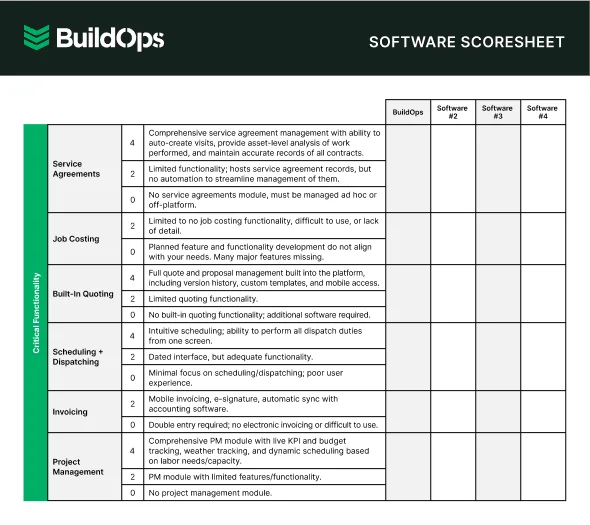
Easily compare software options
See how the leading tools stack up with this easy-to-use scoresheet.
5 benefits of using a field service mapping software
When your techs are on the road and the office is managing multiple schedules, field service mapping software becomes a lifeline. It’s not just about plotting routes—it’s about improving how fast, how accurately, and how profitably work gets done. From fewer missed appointments to tighter reporting, the benefits stack up quickly when your mapping tools are dialed in.
1. Faster response times and improved booking accuracy
The moment a service call comes in, dispatch needs to act fast—especially with emergency jobs. With location-aware software, jobs are assigned to the nearest available tech, speeding up response times and helping your team stay ahead of customer expectations. This precision also tightens your appointment windows and eliminates scheduling overlaps. That’s why mapping integrations are critical for systems like field service booking software, where even small delays can disrupt the entire day’s workflow.
2. Reduced fuel use and more efficient routing
Cutting miles off the day doesn’t just save gas—it saves time, money, and stress on your fleet. With optimized routing baked into field service mapping software, techs get the fastest path to each job, and dispatch avoids sending trucks in circles across town. This benefit compounds over time, reducing vehicle wear and total operational costs. The real win comes when mapping connects with field service routing, offering smarter assignments and more predictable drive times.
3. Fewer scheduling conflicts and missed jobs
One of the biggest headaches for dispatchers is overlapping schedules and double bookings. Mapping tools give the visibility needed to see where techs are, where they’re headed, and where there’s still time to fit in another job. It helps avoid no-shows, late arrivals, and those painful callbacks from frustrated clients. Pairing field service mapping software with tools like field service scheduling keeps calendars clean and aligned—every job in the right place, at the right time.
4. Stronger reporting tied to actual field activity
It’s one thing to track hours and job completions—it’s another to visualize that data on a map. When your software links location data with job outcomes, you can spot trends like slow zones, high-performing crews, or frequent return visits. These insights help you optimize routes, prioritize training, or shift workloads. If you’re serious about improving how your field ops perform over time, field service reporting is where mapping and metrics come together.
5. Better customer communication and accountability
Clients expect updates: when the tech’s arriving, how long the job will take, and what’s being done. When mapping tools sync with your CRM, office staff can relay that info with confidence, while techs can review client history and notes before pulling into the driveway. It builds trust, cuts down confusion, and ensures everyone’s on the same page. Tying this to your field service CRM software ensures every job feels personalized—even when you’re managing dozens a day.
4 common field service mapping software FAQs answered
If you’re still figuring out whether field service mapping software makes sense for your crew, you’re not alone. Contractors across trades are asking the same questions: what exactly does it do, how does it work, and is it worth the investment? We break down the answers here to help you make a clear call.
1. What is field service mapping software?
Field service mapping software is a tool that tracks the real-time location of field technicians, assigns jobs based on location and availability, and optimizes routes to reduce travel time, improve response rates, and keep dispatch and field crews in sync. It goes beyond simple GPS tracking.
This software connects the dots between scheduling, dispatching, and on-site execution—giving dispatchers a live view of who’s doing what and where. It’s a crucial tool for managing multiple jobs, tight schedules, and large fleets without losing visibility.
2. How does field service mapping software work?
This kind of software pulls together several moving parts to give you real-time control over your field team. It connects job scheduling, technician availability, and GPS tracking into one platform, then uses that data to optimize job assignments and crew movement.
Here’s what it typically does:
- Tracks the location of every tech via GPS
- Syncs with your scheduling system to assign jobs
- Suggests optimal routes for each job
- Shows live updates on job status and technician availability
- Flags delays, idle time, or job overlaps
- Gives field crews instant access to job details and directions
By combining visibility with automation, the system cuts manual communication and makes sure the right person is always on the move—at the right time.
3. Is field service mapping software worth the cost?
For most service contractors, the answer is yes—and quickly. The cost of delays, missed jobs, and wasted fuel adds up fast. Mapping software helps eliminate those inefficiencies by optimizing schedules and reducing miscommunication between the field and office. Think about what happens when a tech gets lost, runs late, or shows up without the info they need. Multiply that by five, ten, or twenty techs a day. The software pays for itself in fewer call-backs, tighter job timing, and better use of your crew’s hours.
4. Who needs field service mapping software?
This tool isn’t just for massive operations with hundreds of trucks. If you dispatch anyone to job sites and rely on coordination between field and office, field service mapping software can level up your operations. You’ll especially benefit if you:
- Manage multiple jobs or job sites per day
- Run a fleet of field techs across a region or city
- Need to reduce fuel use and drive times
- Handle urgent or same-day service requests
- Want real-time updates from your team in the field
Whether you’re a commercial HVAC firm, an electrical contractor, or a multi-trade service provider, this software closes the loop between planning and execution—so no job gets lost in the shuffle.
The tools you use in the field can make or break your schedule. That’s why field service mapping software has become essential for contractors managing multiple crews, scattered jobs, and tight deadlines. From faster dispatching to route optimization and better crew visibility, this software isn’t just about tracking trucks—it’s about running a tighter operation from every angle.
Not every platform brings all these capabilities under one roof. Many fall short when it comes to real-time updates, mobile access, or integration with key tools like CRM and invoicing. That’s where an all-in-one solution designed for commercial field service—like BuildOps—fills the gap. It’s built to handle the complexity, speed, and scale that serious contracting teams deal with every day.
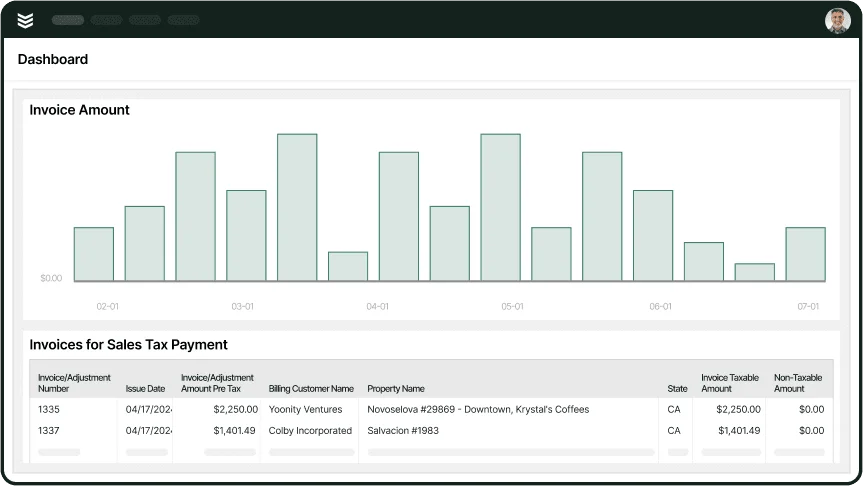
Curious how BuildOps works?
See how mapping, dispatch, and your entire workflow can operate seamlessly together.




